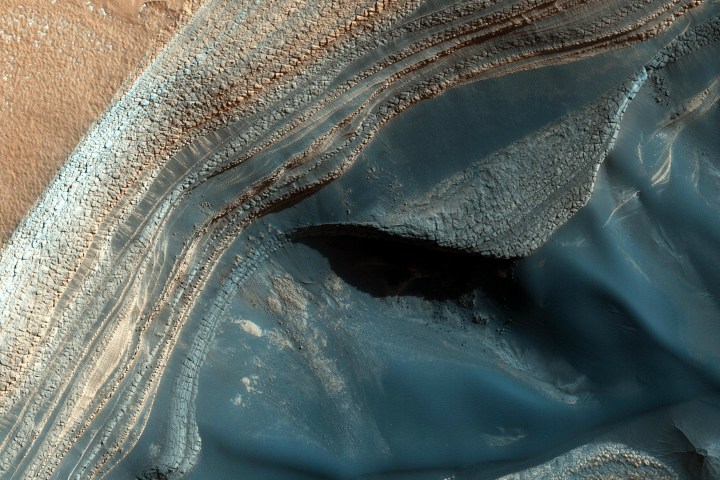
Not really, of course, but the discovery does suggest that future missions to the Red Planet would be able to attain drinking water and make rocket fuel, both of which would be crucial to their success. The discovery was made using NASA’s Mars Reconnaissance Orbiter (MRO), and involves “eight sites where thick deposits of ice beneath Mars’ surface are exposed in faces of eroding slopes,” according to a NASA news release.
The ice deposits could help scientists glean more information about underground ice sheets in the middle latitudes of Mars, which had previously gone undetected. Researchers believe that the ice initially took the form of snow many, many years ago. Now, however, it remains as “relatively pure water ice” though it is “capped by a layer one to two yards thick of ice-cemented rock and dust.”
The findings were reported this week in the journal Science. The study’s lead author, Colin Dundas of the U.S. Geological Survey’s Astrogeology Science Center, noted, “There is shallow ground ice under roughly a third of the Martian surface, which records the recent history of Mars. What we’ve seen here are cross-sections through the ice that give us a 3-D view with more detail than ever before.”
And not only are we seeing the ice in more detail, but we’re also seeing just how available it would be to both robotic and manned missions. “Astronauts could essentially just go there with a bucket and a shovel and get all the water they need,” said Shane Byrne of the University of Arizona Lunar and Planetary Laboratory, the report’s co-author.
But aside from its importance as a resource, the ice also provides scientists with clues about long-term climate patterns on Mars. “If you had a mission at one of these sites, sampling the layers going down the scarp, you could get a detailed climate history of Mars,” said MRO Deputy Project Scientist Leslie Tamppari of NASA’s Jet Propulsion Laboratory, Pasadena, California. “It’s part of the whole story of what happens to water on Mars over time: Where does it go? When does ice accumulate? When does it recede?”
Editors' Recommendations
- NASA’s Mars rover uses its self-driving smarts to navigate toughest route
- NASA’s Mars helicopter aces longest flight in almost a year
- NASA’s InSight lander detects ‘monster quake’ on Mars
- NASA’s Mars drone captures cool shots of rover landing gear
- Moon, Mars, and more: NASA extends 8 planetary missions


